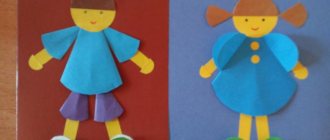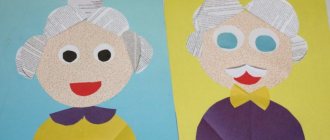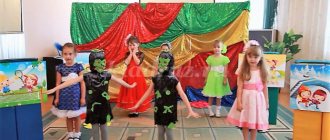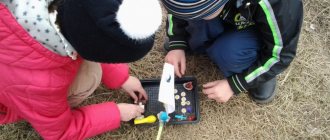↑ Types of activities
Depending on the subject, activity can be individual
or
collective
.
By nature: reproductive
(repeating what has already been achieved) and
productive
- creative (a type of activity that generates something qualitatively new, never existing before).
According to social norms: legal - illegal, moral - immoral
.
In relation to social progress: progressive - reactionary, creative - destructive.
In the sphere of public life: economic, social, political, spiritual.
According to the characteristics of the manifestation of human activity: external - internal.
The main types of activities that ensure the existence of a person and his formation as an individual are communication, play, learning and work
.
Play is the main activity of preschool children. Briefly
Play is the main activity of preschool children
The main activity of preschool children is play, during which the child’s spiritual and physical strengths develop: his attention, memory, imagination, discipline, dexterity, and so on.
In addition, play is a unique way of learning social experience, characteristic of preschool age. A special place is occupied by games that are created by children themselves - they are called creative or role-playing games. In these games, children reproduce everything that they see around them in the life and activities of adults. Children choose the game themselves and organize it themselves. In the game you begin to feel like a member of a team. Moral qualities formed in the game influence the child’s behavior in life. Communication with peers is especially important for children growing up alone in the family. By communicating with them, the child gets the opportunity to gain experience that matches his aspirations and interests. Play and any other activity takes on a special meaning for him, provided that he has a partner. The reason for communication is the child’s desire to teach others what he can do, to share his impressions. Play activities in a preschool institution. The main activity of preschool children is play, during which the child’s spiritual and physical strength develops; his attention, memory, imagination, discipline, dexterity. In addition, play is a unique way of assimilating social experience, characteristic of preschool age. All aspects of a child’s personality are formed in play, significant changes occur in his psyche, preparing the transition to a new, higher stage of development. This explains the enormous educational potential of play, which psychologists consider the leading activity of a preschooler. A special place is occupied by games that are created by the children themselves 1. Role-playing games 2. Creative games Game is a reflection of life . Imitating adults in play is associated with the work of the imagination. The child does not copy reality; he combines different impressions of life with personal experience. Play is an independent activity in which children first interact with peers. They are united by a common goal, joint efforts to achieve it, common interests and experiences. Play is a multiple phenomenon; it can be considered as a special form of existence of all aspects of a child’s life without exception. The teacher’s task is to focus the attention of the players on goals that would evoke a commonality of feelings and actions, and to promote the establishment of relationships between children based on friendship, justice, and mutual responsibility. Play is an important means of mental education of a child ; in play, children’s mental activity is always associated with the work of their imagination. In play, all aspects of a child’s personality are formed in unity and interaction. Game management is one of the most difficult sections of preschool education methods; the teacher cannot foresee in advance what the children will come up with and how they will behave in the game. Therefore, the uniqueness of children's activities requires unique management techniques. The most important condition for successful management of games is the ability to win the trust of children and establish contact with them. Should the teacher intervene in the game? - yes, if this is required in order to give the game the right direction, but an adult’s intervention will only be successful when he enjoys sufficient respect and trust from children, when he knows how, without violating their plans, to make the game more exciting. The main way of education in a game is to influence its content, the choice of theme, the development of the plot, the distribution of roles and the implementation of game images. The tasks of the teacher when organizing the game : - help organize the games - make them exciting - make them action-packed - help the child choose from the mass of life experiences the most vivid ones that can serve as the plot of a good game Mistakes of teachers when organizing the game - imposing ready-made games - games according to a specific plan - pattern of games - restriction of the child’s initiative “We must influence the children, and influence very strongly, but in such a way as to give a certain development to the forces, not to lead them by the hand, not to regulate every word, but to give the opportunity for comprehensive development through play, communication, observing the environment." Makarenko A.S. To resolve the issue of methods of influencing children's gaming activities , it is necessary to understand what guides them in choosing a game. The experience of teachers shows that the only correct way to manage a game is to create interest in a particular life event and influence the imagination and feelings of children. Based on the interests of children and their ideas, the teacher can guide the choice of games. Taking all this into account, the game gradually becomes more and more purposeful, becomes more meaningful and interesting.
We recommend watching:
Musical and aesthetic education of children 3-4 years old through play Game as a means of development of preschool children in the context of the implementation of the Federal State Educational Standard Game technologies in kindergarten Game therapy for preschool children
Similar articles:
Game as a means of development of preschool children
↑ Communication as a type of activity
Communication
- a type of activity during which information is transferred from one individual to another, thoughts, feelings and emotions are exchanged.
It is often expanded to include the exchange of material items. This broader exchange constitutes communication.
Communication
— communication, the transfer of information from person to person, a form of interaction between people.
Communication structure:
Subjects
- those between whom communication takes place (individuals, groups, communities, humanity as a whole)
Target
- this is what a person needs to communicate for
Content
- these are ideas, emotions that are transmitted in interpersonal contacts from one to another
Facilities
- these are methods of transmission (using the senses, texts, drawings, diagrams, radio-video equipment, the Internet, etc.)
Same thing again
Communication
is a process of interaction between people, as a result of which information, emotions, and moods are transferred.
Subjects
: Really existing partners; illusory partners (they are assigned qualities of a subject of communication that are unusual for them, for example, talking with a pet); imaginary partners (talk to oneself, with an artistic image)
Goals
(that for which a person has a need for interpersonal relationships): transfer and receipt of knowledge; coordination of reasonable actions of people; organization of joint activities of people; establishing and clarifying interpersonal relationships, etc.
Content
(information transmitted in the process of communication): knowledge, experience, skills, emotions, feelings
Communication means
(methods of transmission, processing and decoding of information):
- sense organs (vision, hearing, smell, touch);
- oral speech;
- written language (drawings, signs, images);
- technical means (radio, television, computer)
functions
:
- communicative
(implementation of the relationship between people at the level of individual, group and public interaction); - cognitive
(obtaining new information); - socialization
(formation of interaction skills in society); - psychological
(emotional support);
Types of communication
| Direct - personal contact, communication requires visual perception of each other | Business (formal) - communication in the professional sphere, relies more on document flow. | Verbal - communication through speech. | Interpersonal - communication between two people. |
| Indirect - communication through other people. | Personal (informal) - conversation on any topic, communication between friends and loved ones. | Nonverbal - communication through facial expressions, gestures, postures. | Group - communication between three or more people. |
The essence of the concept of “game” and its characteristics
The essence of the concept of “game” and its characteristics
Defining a game is one of the most difficult problems in pedagogy. According to L.S. Vygotsky, there are many different definitions of play. We'll look at some of them.
An analysis of psychological and pedagogical literature has shown that different teachers have their own views on the concept of “game”.
In pedagogical literature, the understanding of play as a reflection of real life was first expressed by the great teacher K.D. Ushinsky. The environment, he says, has a powerful influence on play, “it provides material for it that is much more varied and real than that offered by the toy store.” K.D. Ushinsky proved that the content of the game influences the formation of the student’s personality. [26]
In the creation of game theory, a special role is given to the research of N.K. Krupskaya. She considers play to be a need of a growing organism and explains this by two factors: the student’s desire to learn about the life around him and his characteristic imitation and activity. “A game for pupils is a way of learning about their surroundings.” [16]
Preschool age is the initial stage of assimilation of social experience. Play is the most accessible type of activity for a student, a unique way of processing received impressions. At preschool age, for the first time he becomes such that an adult, a bearer of social functions, becomes the model of his behavior. A child wants to be like an adult, but cannot be one due to his age. And then he can “be an adult” only in the game. In it, the student takes on the role of an adult and plays it out in an imaginary situation. [2]
A.P. Usova determined that play is a special form of mastering reality in terms of orientation to the meanings of life, a form of organizing children’s life that is amateur and creative in nature, in which the child takes the first steps towards an independent life. [26]
K. Gross believed that play is the unconscious preparation of a young organism for life. [8]
K. Bühler believed that the game brings pleasure. It is the joy of the action itself. In the game, the pupil receives functional pleasure from the actions themselves. Having experienced pleasure in the game, he tries to renew it by repeating actions and movements. Over the course of these repetitions, his behavior improves. The game shows what goal a person is striving for, what he is preparing for, what he expects. The game guesses the directions of his future life. A child lives in a small world: apartment, family, toys. And he tries to push the boundaries of this world with the help of the game. He builds the world of adults he observes with the help of his imagination.[4]
A.N. Leontyev noted that new, progressive formations develop in the game and a powerful cognitive motive arises, which is the basis for the emergence of an incentive to study. [9]
So, having analyzed various approaches to the definition of a game, we consider the most complete and meaningful definition given in the pedagogical dictionary. A game is a type of activity in situations aimed at recreating and assimilating social experience in which self-control of behavior is developed and improved. [14]
The study of children's games reveals patterns of their development associated with general patterns of development in preschool age, the formation of thinking, imagination, moral qualities, quantitative skills, and creative abilities. At the same time, the game reveals the individual characteristics of the students, different interests, and characters. To understand the essence of the game and the patterns of their development, it is important to trace the emergence of the game and study its initial forms. The study of this material allows us to understand the prerequisites for the emergence of a role-playing game. [19, p.10]
The development of the content of children's games is significantly influenced by the production of homemade toys, which make children's gaming interests more stable and help them unite in play. When leading the game, we, however, should not suppress the initiative and independence of children. [20]
Play as the leading activity of a preschool child has an impact on the development of attention and memory. The need to communicate with a peer forces the student to strictly follow the rules of the game, and this requires special effort and focus. For the development of thinking and imagination, play is of decisive importance, since in play activities the child learns to replace one object with another and “try on” various roles, images and actions. The influence of the game on personality development lies in the fact that in it the student masters relationships between people in the image and likeness of adults, thus acquiring communication skills and methods of volitional regulation of his behavior. [12, p.14]
Productive activities continue to develop in the game, and elements of educational work activity appear. Play is an independent, creative, free activity of a child.
S.A. Shmakov identifies four main features in the game:
- free developmental activity, undertaken only at the request of the child, for the sake of pleasure from the process of activity itself, and not just from the result;
- creative, largely improvisational, very active nature of this activity;
- emotional elation of activity, rivalry, competitiveness, competition, attraction, etc.;
— the presence of direct or indirect rules that reflect the content of the game, the logical and temporal sequence of its development.
The structure of the game as an activity organically includes goal setting, planning, goal implementation, as well as analysis of the results in which the individual fully realizes himself as a subject. The motivation of gaming activity is ensured by its voluntariness, opportunities for choice and elements of competition, satisfying the need for self-affirmation and self-realization. [25]
Children's games are very diverse. They differ in content and organization, rules, the nature of children’s manifestations, the impact on the pupil, the types of objects used, origin, etc. All this makes it difficult to classify games, but for proper management of games, grouping them is necessary. Each type of game performs its own function in the development of a child. The blurring of lines between amateur and educational games observed today in theory and practice is unacceptable. In preschool age, there are three classes of games:
- games that arise on the child’s initiative - amateur games;
- games that arise on the initiative of an adult who introduces them for educational and educational purposes;
- games that come from the historically established traditions of the ethnic group - folk games that can arise both on the initiative of an adult and older children.[26]
There are different types of games:
— outdoor play is an indispensable means of replenishing a child’s knowledge and ideas about the world around him, developing thinking, ingenuity, dexterity, dexterity, and valuable moral and volitional qualities. When conducting outdoor play, there are unlimited possibilities for the integrated use of various methods aimed at shaping the child’s personality;
- didactic game - a specially created game that performs a specific didactic task hidden from the child in a game situation behind game actions;
- dramatization game - a game that is based on the plot scheme of a literary work or fairy tale;
— role-playing games are games that the students themselves come up with. Games reflect the child’s knowledge, impressions, and ideas about the world around him; social relationships are recreated;
- constructive game - where students reflect their knowledge and impressions about the surrounding objective world, do some things on their own, erect buildings and structures, but in a generalized, schematized form. [9]
All types of games can be combined into two large groups, which differ in the degree of direct participation of an adult, as well as different forms of children's activity.
The first group is games where an adult takes an indirect part in their preparation and conduct. The activity of pupils is of an initiative, creative nature - children are able to independently set a game goal, develop the concept of the game and find the necessary ways to solve game problems.
The second group is various educational games in which an adult, telling the child the rules of the game or explaining the design of a toy, gives a fixed program of actions to achieve a certain result. These games usually solve specific problems of education and training; they are aimed at mastering certain program material and rules that players must follow. [18]
Thus, it turns out that most teachers, such as L.S. Vygotsky, N.K. Krupskaya, A.N. Leontiev, K. Buller, K.D. Ushinsky and others have their own view on the concept of game.
Some believe that play is the unconscious preparation of a young organism for life, others believe that it is the joy of the action itself, others argue that new, progressive formations develop in the game, which is the basis for the emergence of an incentive to learn.
However, all researchers agree that play is an integral part in the life of preschoolers.
5
↑ Game as a type of activity
A game
- this is a type of activity that is aimed at satisfying spiritual needs and the goal of which is not the production of a material product, but the process itself - relaxation, entertainment.
Characteristic features of the game:
- Occurs in a conditional situation, which, as a rule, changes quickly.
- Certain items are used during the game
- Aimed at satisfying the interests of its participants
- Promotes personality development, enriches it, equips it with the necessary skills.
Stages of game development
D. B. Elkonin identified several types of games that gradually became more complex:
- Object-manipulative game. Here the child’s actions come down to imitation.
- Role-playing game. This type of game is aimed at mastering the norms of interpersonal relationships.
- A game with rules.
Let's also consider the classification of game methods according to N. Ya. Mikhailenko :
- Conditional objective actions.
- Behavior in the context of a particular role.
- Development of the plot.
Next, we will study the role of play in the development of a child’s psyche :
- Game as a way to study the characteristics of interpersonal interaction.
- Game as a way to study the peculiarities of the subordination of motives.
- Development of moral authorities.
- Formation of qualitatively new motives.
- Formation and development of new productive activities.
Let us also consider the features of play activities of preschoolers .
Older preschoolers are mainly attracted to role-playing games . The peculiarity of these games is that they can use some objects as substitutes for others, and also play various roles. It is especially common for preschoolers to imitate adults in their games. Thus, here we can talk about laying down a certain model of behavior.
Finished works on a similar topic
Course work Game activity 420 ₽ Abstract Game activity 280 ₽ Test work Game activity 240 ₽
Receive completed work or specialist advice on your educational project Find out the cost
Another important characteristic is that for children the process of the game than its result. Children play for the sake of the game itself, for the sake of the emotional reactions that he receives in it, and also for the sake of communication with other peers.
Quite often, in their games, children demonstrate issues that have ever been raised by their parents. In addition, children have no problem replacing one item with a completely different one, giving it the same meaning and functions.
Children 5-6 years old are able to concentrate on a game plot for several hours and even days. Also, as they grow older, they give preference to certain game situations. While in younger preschool age everyday topics predominate, on average, production circumstances are of greater interest, and older preschoolers are captivated by socio-political scenarios, often intertwined with the plots of their favorite films or books. Rules for play activities of preschool children.
The development of play activity in preschoolers shows noticeable progress as children move from one age group to another. Kids are not able to plan the development of the plot, and more often repeat the same actions of adults.
Older children demonstrate creativity, and consider the relationships between players to be the most important in the game. Older children value the distribution of roles and adherence to the rules of the game.
↑ Labor as a type of activity
Work
is a human activity aimed at obtaining a practically useful result, which makes it possible to satisfy one’s needs.
In the process of labor activity, a person produces the material and spiritual values he needs. Unlike study and play, work requires a person to have certain training or qualifications,
for example: a miner cannot perform a surgical operation.
Qualification -
the level of knowledge, abilities, skills and competence that characterizes readiness to perform a certain type of professional activity.
Characteristic features of work:
- Feasibility
- Focus on achieving programmed expected results
- Availability of skills, abilities, knowledge.
- Practical usefulness
- Availability of result
- Personal development
- Transformation of the external human environment
↑ Material and spiritual activity
Based on objects and results, activities are divided into material and spiritual.
Material (practical) activities
associated with practice, creating something new or changing the old order of things.
Material activity, in turn, is divided into two main groups: material-production and social-transformative.
Material and production
activity represents the creation of material wealth, the enrichment of the culture of humanity as a whole. For example, construction, factory production, crafts.
Social transformative activities
associated with changes in society. This type of activity includes the publication of new legislative acts and implementation of reforms.
Spiritual activity
is a process associated with intelligence and creativity, aimed at the spiritual development of the world.
It includes cognitive, value-oriented and prognostic activities.
Cognitive (educational and cognitive)
activities are associated with obtaining new knowledge about the world, events and patterns.
The establishment and formation of spiritual values in society or a value-based attitude towards things is a value-oriented activity
.
Prognostic activity
- making forecasts or plans for the future, foreseeing the results of one’s actions or future events.
The results of spiritual activity are new ideas, values, ideas, which are subsequently embodied in philosophical concepts, scientific theories, works of art, moral, religious, legal and other norms.
Historical forms of spiritual activity are religion, morality, art, science, philosophy, law, political ideology, and spiritual production
- this is the result of activity in these areas, namely spiritual values and benefits.
Spiritual production -
production of spiritual values, those. ideas, ideas, scientific knowledge, ideals, as well as the entire system of human activity associated with this process.
Activities may also vary in nature. Thus, they distinguish the conscious
(conscious setting of goals and their achievement),
productive
(creation of a useful product),
instrumental
(creation of tools),
transformative
(changing the environment, society, self-improvement) and
social
(interaction with people)
nature of activity
.






